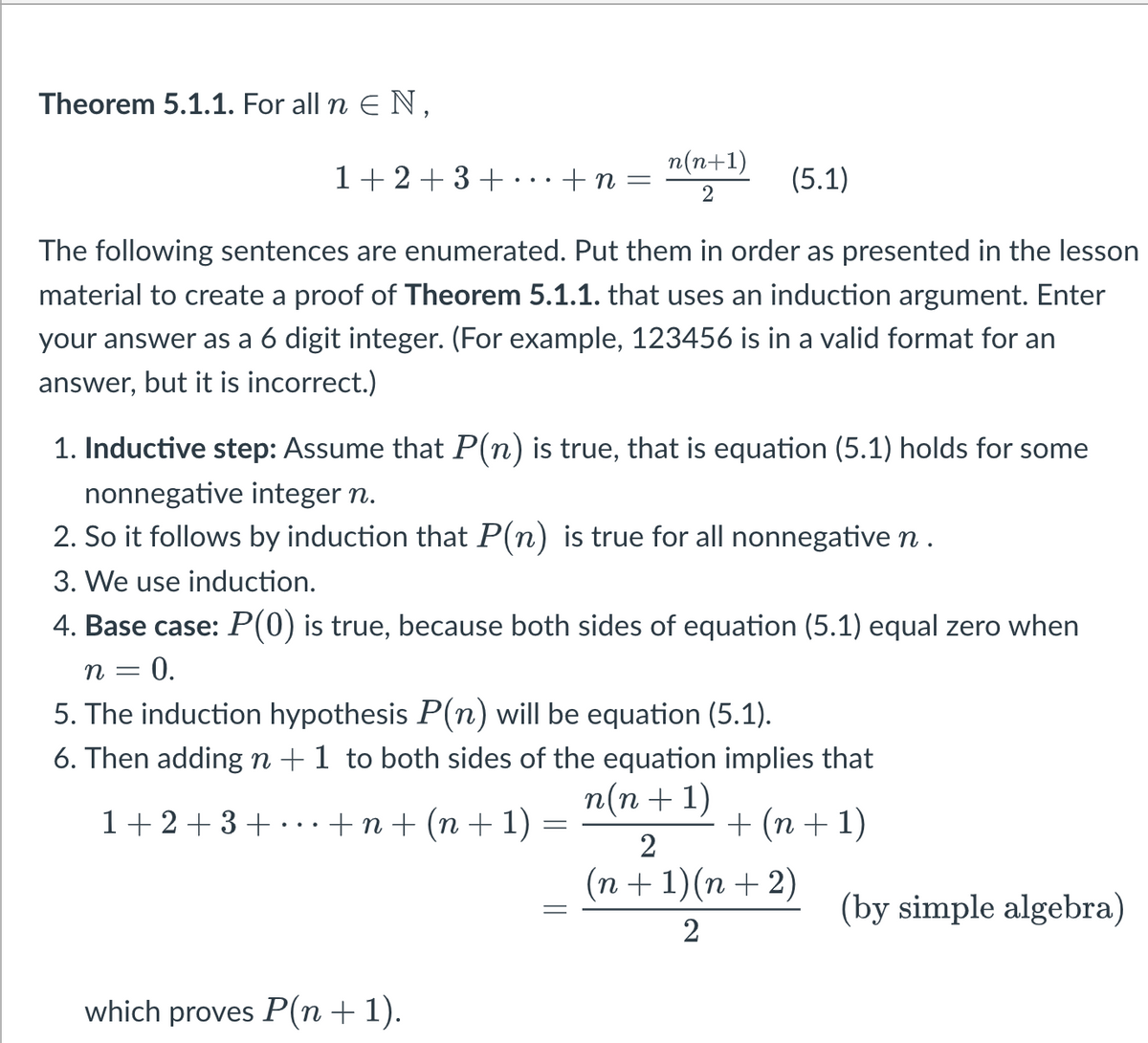Theorem 5.1.1. For all n E N, 1+2+3+...+n = 2 m(a+1) (5.1) The following sentences are enumerated. Put them in order as presented in the lesson material to create a proof of Theorem 5.1.1. that uses an induction argument. Enter your answer as a 6 digit integer. (For example, 123456 is in a valid format for an answer, but it is incorrect.) 1. Inductive step: Assume that P(n) is true, that is equation (5.1) holds for some nonnegative integer n. 2. So it follows by induction that P(n) is true for all nonnegative n . 3. We use induction. 4. Base case: P(0) is true, because both sides of equation (5.1) equal zero when = 0. 5. The induction hypothesis P(n) will be equation (5.1). 6. Then adding n +1 to both sides of the equation implies that n(n + 1) 1+2+3+ +n+ (n +1) : + (n + 1) 2 (n + 1)(n + 2) (by simple algebra) which proves P(n + 1). ||
Theorem 5.1.1. For all n E N, 1+2+3+...+n = 2 m(a+1) (5.1) The following sentences are enumerated. Put them in order as presented in the lesson material to create a proof of Theorem 5.1.1. that uses an induction argument. Enter your answer as a 6 digit integer. (For example, 123456 is in a valid format for an answer, but it is incorrect.) 1. Inductive step: Assume that P(n) is true, that is equation (5.1) holds for some nonnegative integer n. 2. So it follows by induction that P(n) is true for all nonnegative n . 3. We use induction. 4. Base case: P(0) is true, because both sides of equation (5.1) equal zero when = 0. 5. The induction hypothesis P(n) will be equation (5.1). 6. Then adding n +1 to both sides of the equation implies that n(n + 1) 1+2+3+ +n+ (n +1) : + (n + 1) 2 (n + 1)(n + 2) (by simple algebra) which proves P(n + 1). ||
Elements Of Modern Algebra
8th Edition
ISBN:9781285463230
Author:Gilbert, Linda, Jimmie
Publisher:Gilbert, Linda, Jimmie
Chapter2: The Integers
Section2.3: Divisibility
Problem 49E: 49. a. The binomial coefficients are defined in Exercise of Section. Use
induction on to prove...
Related questions
Question

Transcribed Image Text:Theorem 5.1.1. For all n E N,
n(n+1)
1+2+3+
+n =
(5.1)
..
The following sentences are enumerated. Put them in order as presented in the lesson
material to create a proof of Theorem 5.1.1. that uses an induction argument. Enter
your answer as a 6 digit integer. (For example, 123456 is in a valid format for an
answer, but it is incorrect.)
1. Inductive step: Assume that P(n) is true, that is equation (5.1) holds for some
nonnegative integer n.
2. So it follows by induction that P(n) is true for all nonnegative n.
3. We use induction.
4. Base case: P(0) is true, because both sides of equation (5.1) equal zero when
= 0.
5. The induction hypothesis P(n) will be equation (5.1).
6. Then adding n+1 to both sides of the equation implies that
п(п + 1)
1+2+ 3+ ·..+n+ (n + 1)
+ (n + 1)
2
(n + 1)(n + 2)
(by simple algebra)
2
which proves P(n +1).
Expert Solution
This question has been solved!
Explore an expertly crafted, step-by-step solution for a thorough understanding of key concepts.
This is a popular solution!
Trending now
This is a popular solution!
Step by step
Solved in 2 steps with 2 images

Recommended textbooks for you

Elements Of Modern Algebra
Algebra
ISBN:
9781285463230
Author:
Gilbert, Linda, Jimmie
Publisher:
Cengage Learning,

College Algebra
Algebra
ISBN:
9781305115545
Author:
James Stewart, Lothar Redlin, Saleem Watson
Publisher:
Cengage Learning

Algebra and Trigonometry (MindTap Course List)
Algebra
ISBN:
9781305071742
Author:
James Stewart, Lothar Redlin, Saleem Watson
Publisher:
Cengage Learning

Elements Of Modern Algebra
Algebra
ISBN:
9781285463230
Author:
Gilbert, Linda, Jimmie
Publisher:
Cengage Learning,

College Algebra
Algebra
ISBN:
9781305115545
Author:
James Stewart, Lothar Redlin, Saleem Watson
Publisher:
Cengage Learning

Algebra and Trigonometry (MindTap Course List)
Algebra
ISBN:
9781305071742
Author:
James Stewart, Lothar Redlin, Saleem Watson
Publisher:
Cengage Learning

Linear Algebra: A Modern Introduction
Algebra
ISBN:
9781285463247
Author:
David Poole
Publisher:
Cengage Learning